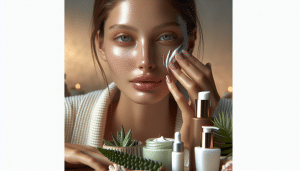Facial Serums You Might Want to Explore Today
Natalie Brooks September 17, 2025
Uncover how facial serums can elevate your daily beauty routine and potentially support radiant, healthy-looking skin. This guide covers serum types, how to use them, and expert-backed advice for maximizing their effects. Learn how these powerful, targeted treatments can fit seamlessly into your wellness and beauty regimen.
Understanding Facial Serums and How They Work
Facial serums have gained a reputation for delivering targeted benefits to skin. Often lighter than creams and packed with concentrated ingredients, serums are formulated to address specific wellness and beauty concerns. They can be used for a variety of skin goals, including hydration, brightening, and supporting skin firmness. Unlike moisturizers, serums typically feature high-potency actives designed to penetrate the surface layers and provide visible results over time. With a proper understanding of their ingredients and use, serums can seamlessly enhance any skincare routine.
Choosing the right serum goes beyond just picking a pretty bottle. Serums are available with a range of active components, including hyaluronic acid for plumping, vitamin C for brightening, or retinol for smoother texture. Each ingredient is tailored to address unique complexion needs. For example, those aiming to support a firmer appearance may find peptides useful, while niacinamide soothes and balances. Doing research and matching ingredients to skin concerns can make a noticeable difference. Many dermatologists recommend introducing serum gradually, observing skin tolerance and results.
It’s important to apply serums properly for the benefits to shine through. Typically, serums are used on clean, dry skin prior to heavier products like creams or sunscreen. Just a few drops can cover the entire face and neck, allowing for efficient absorption. Using a gentle patting motion instead of rubbing minimizes irritation. Incorporating a thoughtfully chosen serum is a step appreciated by both wellness enthusiasts and skincare professionals for its ability to provide concentrated support where it’s needed most (Source: https://www.aad.org/public/everyday-care/skin-care-basics/care/skin-care-facts).
Key Ingredients Found in Popular Facial Serums
Active ingredients are the star performers in every serum. Hyaluronic acid stands out for its remarkable moisture-binding properties, making it ideal for those seeking a hydrated, plump look. Vitamin C, celebrated for its antioxidant powers, helps with brightening and supports the skin’s natural resilience against daily stressors. For people interested in a smoother skin texture, retinol (a vitamin A derivative) is often recommended by skin specialists. These ingredients are often featured in wellness and beauty discussions due to their high demand and visible impact.
Beyond the classics, other compounds are earning a trusted place in modern serum formulations. Peptides support a bouncy, youthful look by encouraging regeneration at a cellular level. Niacinamide can minimize the appearance of pores and calm the skin, contributing to an even tone. Meanwhile, botanical extracts like green tea and licorice root offer additional soothing and protective effects. Many serums contain combinations of these actives for targeted concerns, creating a customizable experience based on individual needs (Source: https://www.health.harvard.edu/staying-healthy/the-benefits-of-serums).
Understanding ingredient lists empowers individuals to make informed decisions. Some consumers prefer serums with minimal additives, while others seek complex blends for multifaceted effects. It’s wise to avoid formulations containing potential irritants if skin is sensitive or compromised. Checking for clinical evidence and dermatologist endorsements can boost confidence in a product. When learning about serums, focusing on ingredients that consistently show results is a key strategy in curating a personal skincare lineup.
How to Incorporate Serums into a Daily Beauty Routine
Routine is everything in skincare. Experts recommend applying serum after cleansing but before heavier creams. This approach allows serum’s beneficial compounds to reach deeper layers without obstruction. Using a dropper or clean fingertips, just a small amount will do. Wait a minute for absorption before applying moisturizer. Adding sunscreen as the final layer is crucial for daytime routines, especially when using active ingredients like vitamin C or retinol (Source: https://www.cancer.org/healthy/be-safe-in-sun/sunscreen-and-sun-safety.html).
Patience and consistency yield the best results. Most serums are intended for once- or twice-daily use, depending on the actives and individual tolerance. Some, like powerful retinoids, may be better suited for nighttime use to reduce sensitivity. Wellness-minded individuals often keep a journal to track changes, noting improvements in skin tone, hydration, or texture over several weeks. Always read product labels for specific guidance on application frequency and method.
Combining serums with complementary wellness habits can amplify their effects. Drinking enough water, sleeping well, and maintaining a balanced diet support the skin’s natural renewal processes. Stress can influence the appearance and feel of skin; integrating relaxation techniques such as meditation or gentle exercise may help. Observing any reactions and seeking professional advice for ongoing issues is part of a mindful approach to both beauty and wellbeing.
Benefits and Considerations When Using Serums
Serums can offer visible benefits, often in a shorter timeframe than traditional moisturizers. According to dermatology sources, clinical trials show improvements in hydration, firmness, and evenness when targeted serums are applied consistently (Source: https://www.ncbi.nlm.nih.gov/pmc/articles/PMC5849435/). With continued use, actives like vitamin C may help reduce the appearance of uneven pigmentation over time. For those hoping to boost their wellness and beauty regimen, a serum can be a valuable addition.
As with any skincare product, there are factors to consider before starting a new serum. Patch testing is recommended to check for adverse reactions, especially for those with sensitive or allergy-prone skin. It’s possible to notice tingling or mild irritation with some serums, particularly those containing AHAs, BHAs, or retinoids—these effects usually fade with regular use. Avoiding overuse and introducing new actives gradually are practical steps for safe enjoyment.
Serums are designed as part of a holistic approach to skin. No single product can guarantee transformation alone, but combining a targeted serum with overall healthy habits can support positive changes. Consulting licensed estheticians or dermatologists helps ensure any special conditions are addressed. By setting realistic expectations and welcoming the journey, users find satisfaction in the subtle, gradual progress serums can provide (Source: https://www.aad.org/public/diseases/a-z/skincare-for-all).
Choosing the Right Serum for Individual Needs
No universal serum fits every skin profile. Exploring options based on individual requirements ensures a tailored approach to beauty. For dryness, look for serums with hyaluronic acid or glycerin. Anti-aging targets often involve retinoids, while those prone to redness may benefit from calming ingredients like aloe or centella asiatica. Consideration for ingredients and concentrations will make the hunt for the ideal serum efficient and rewarding.
Reading product labels and reviews provides guidance, but verifying a serum’s claims with scientific backing is essential (Source: https://www.ncbi.nlm.nih.gov/pmc/articles/PMC4106357/). Some reputable brands disclose results from clinical trials and provide dermatologist recommendations. Sticking to products with a track record of safety and efficacy offers peace of mind. New users may wish to start with lower concentrations and observe changes in skin receptivity over a few weeks.
Visiting a skin care professional or licensed esthetician can help clarify which serum matches specific wellness and beauty goals. If persistent issues arise, such as sensitivity or breakouts, an expert can suggest alternatives. In an era of information overload, focusing on trusted sources and proven products simplifies the process of finding a serum that truly meets unique needs and fits into a sustainable daily regimen.
Trends and Innovations in the World of Facial Serums
The wellness and beauty industry is ever-evolving, and facial serums are no exception. Recent advancements include the rise of clean beauty serums, which emphasize transparency and natural sourcing. Consumers are more informed and interested in plant-based extracts, cruelty-free manufacturing, and biodegradable packaging. These trends reflect a broader commitment to sustainability and ethical wellness, without sacrificing performance or results (Source: https://www.ncbi.nlm.nih.gov/pmc/articles/PMC8807347/).
Pop culture and social media have brought new ingredients to the spotlight, from bakuchiol as a plant-based retinol alternative to the inclusion of probiotics for supporting skin’s barrier function. Customization is growing, with brands offering mix-and-match serums based on diagnostic quizzes or AI-powered recommendations. Wellness seekers appreciate these innovations as they align with individual health, values, and lifestyle preference.
Technology is playing a part in how serums work and how users choose them. New formulations utilize encapsulation to deliver actives steadily, and smart packaging dispenses doses precisely. Looking ahead, the integration of science and personalization will continue to shape facial serum options. Staying updated with reputable sources offers guidance in navigating the fast-changing world of wellness and beauty treatments.
References
1. American Academy of Dermatology Association. (n.d.). Skin care: Tips for healthy skin. Retrieved from https://www.aad.org/public/everyday-care/skin-care-basics/care/skin-care-facts
2. Harvard Health Publishing. (n.d.). The benefits of serums. Retrieved from https://www.health.harvard.edu/staying-healthy/the-benefits-of-serums
3. American Cancer Society. (n.d.). Sunscreen and sun safety. Retrieved from https://www.cancer.org/healthy/be-safe-in-sun/sunscreen-and-sun-safety.html
4. Kafi, R., et al. (2007). Improvement of naturally aged skin with vitamin A (retinol). Archives of Dermatology. Retrieved from https://www.ncbi.nlm.nih.gov/pmc/articles/PMC4106357/
5. American Academy of Dermatology Association. (n.d.). Skin care for all. Retrieved from https://www.aad.org/public/diseases/a-z/skincare-for-all
6. Tabor, A., & Blair, S. (2022). Innovations in the clean beauty sector. Dermatology Research and Practice. Retrieved from https://www.ncbi.nlm.nih.gov/pmc/articles/PMC8807347/








